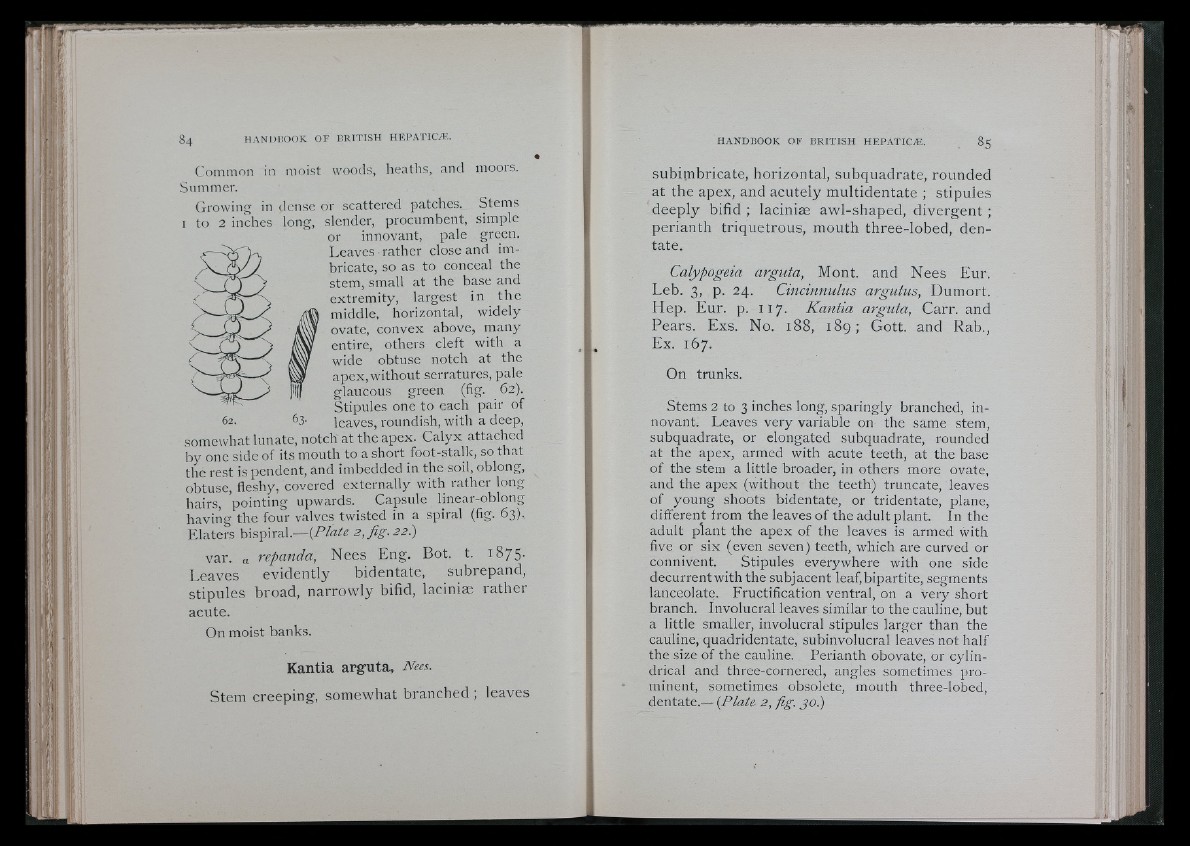
I
Common in moist woods, heaths, and moors.
Summer.
Growing in dense or scattered patches. Stems
1 to 2 inches long, slender, procumbent, simple
62.
or innovant, pale green.
Leaves rather close and imbricate,
so as to conceal the
stem, small at the base and
extremity, largest in _ the
middle, horizontal, widely
ovate, convex above, many
entire, others cleft with a
wide obtuse notch at the
apex, without serratures, pale
glaucous green (fig. 62).
Stipules one to each pair of
63- leaves, roundish, with a deep,
somewhat lunate, notch at the apex. Calyx attached
by one side of its mouth to a short foot-stalk, so thcot
the rest is pendent, and imbedded in the soil, oblong,
obtuse, fleshy, covered externally with rather long
hairs, pointing upwards. Capsule linear-oblong
having the four valves twisted in a spiral (fig. 63),
Elaters bispiral.— (Ttoi; 2, fig. 22)
var. a rcpanda, Nees Eng. Bot. t. 1875.
Lea v e s e vident ly bidentate, subrepand,
st ipules broad, na r rowly bifid, laciniae rather
acute.
On moist banks.
Kantia arguta, Nees.
Stem creeping, somewhat branched ; leaves
subimbricate, horizontal, subquadrate, rounded
at the apex, and acutely multidentate ; stipules
deeply bifid ; laciniæ awl-shaped, dive rg ent ;
perianth triquetrous, mouth three-lobed, dentate.
Calypogeia arguta, Mont. and Nees Eur.
Leb. 3, p. 24. Cincinmdus argutus, Dumort.
Hep. Eur. p. 117. Kantia arguta, Carr, and
Pears. Exs. No. 188, 189; Gott. and Rab.,
Ex. 167.
On trunks.
Stems 2 to 3 inches long, sparingly branched, innovant.
Leaves very variable on the same stem,
subquadrate, or elongated subquadrate, rounded
at the apex, armed with acute teeth, at the base
of the stem a little broader, in others more ovate,
and the apex (without the teeth) truncate, leaves
of young shoots bidentate, or tridentate, plane,
different from the leaves of the adult plant. In the
adult plant the apex of the leaves is armed with
five or six (even seven) teeth, which are curved or
connivent. Stipules everywhere with one side
decurrent with the subjacent leaf, bipartite, segments
lanceolate. Fructification ventral, on a very short
branch. Involucral leaves similar to the cauline, but
a little smaller, involucral stipules larger than the
cauline, quadridentate, subinvolucral leaves not half
the size of the cauline. Perianth obovate, or cylindrical
and three-cornered, angles sometimes prominent,
sometimes obsolete, mouth three-lobed,
dentate.— {Plate 2, fig. g o )
#F:,
! I'